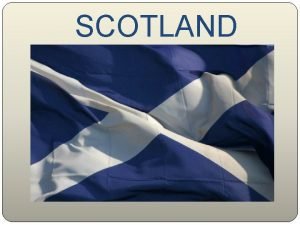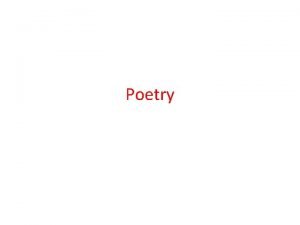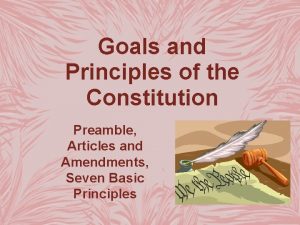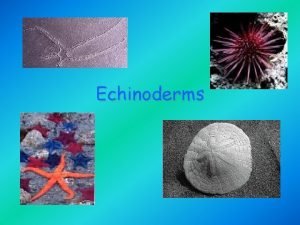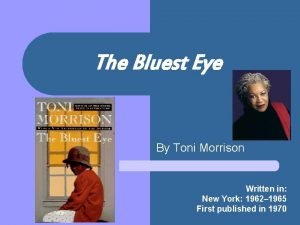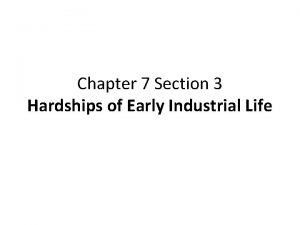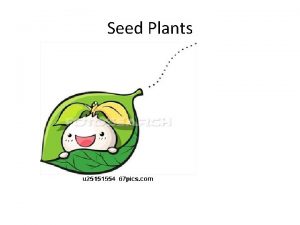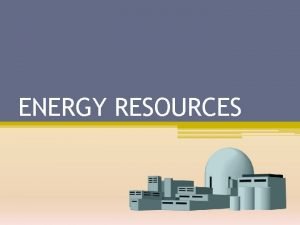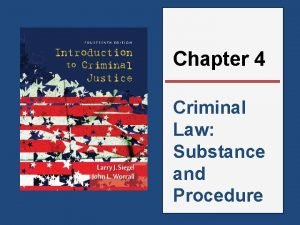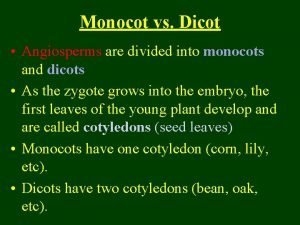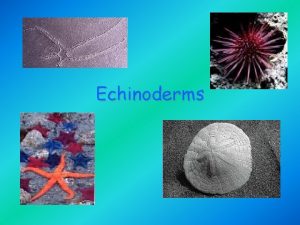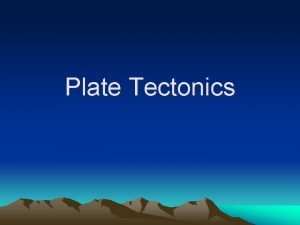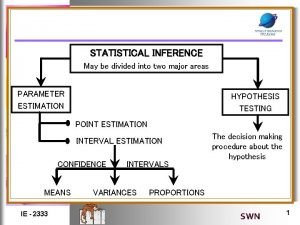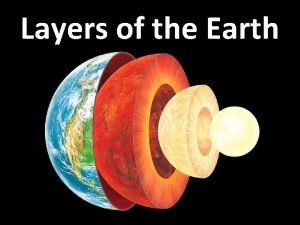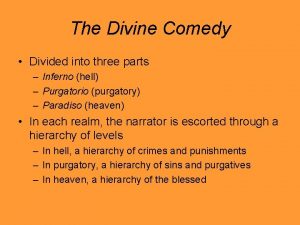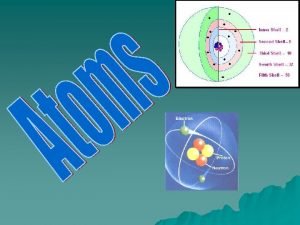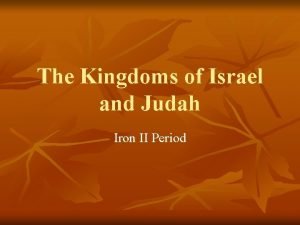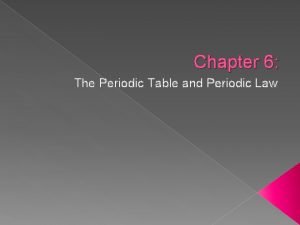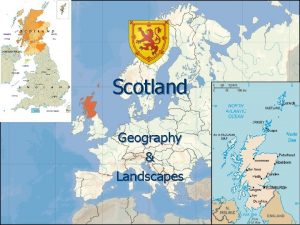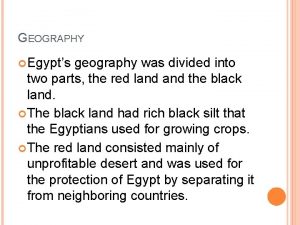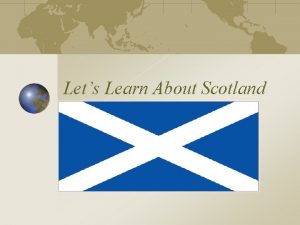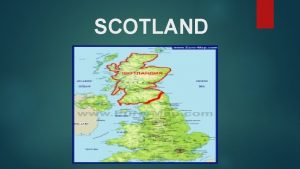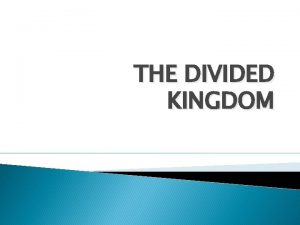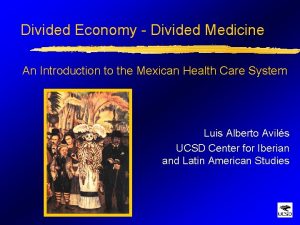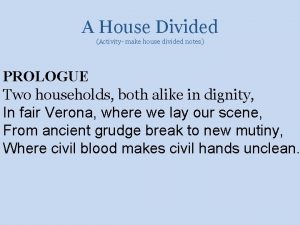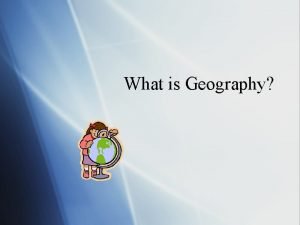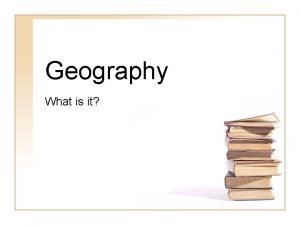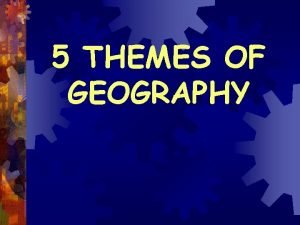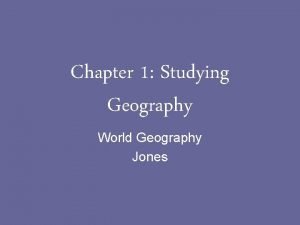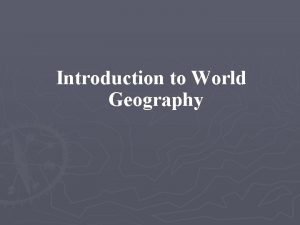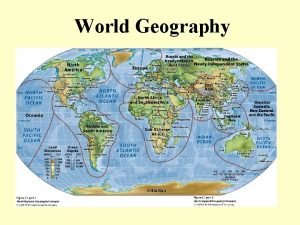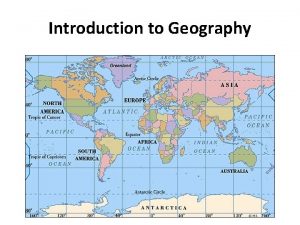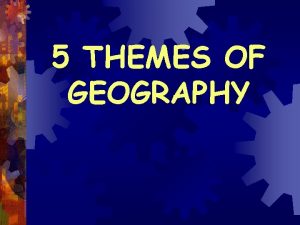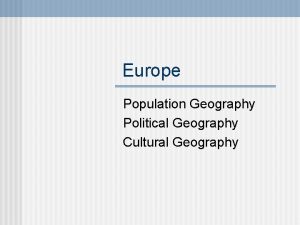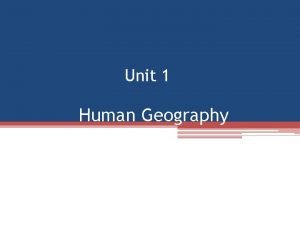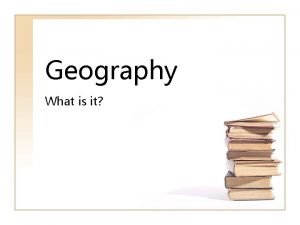SCOTLAND GEOGRAPHY OF SCOTLAND Scotland is divided into































- Slides: 31

SCOTLAND

GEOGRAPHY OF SCOTLAND Scotland is divided into three geographical areas: the Highlands, the Lowlands and the Islands.

Scotland has great diversity of landscapes Green plains Valleys

Romantic rocky coasts

Cliffs

The climate of Scotland is temperate The same latitude of Canada but not so cold

Oceanic climate The western Highlands of Scotland are one of the wettest places in Europe with annual rainfall up to 4, 577 mm

The relief of Scotland Abundant lochs(lakes) Loch Lomond is the largest of United Kingdom. Loch Ness Spectacular mountains, hills and glens (valleys)

Scotland has the highest mountain in Britain, Ben Nevis (1, 347 m) …and 279 mountains over 914 m high.

On its sea-stacks and islands, Scotland supports some of the greatest concentrations of seabirds in the world

The wildlife includes red deer, wildcats, red squirrels… Seals are to be seen in large numbers Rivers still have plenty of wild salmon and trout Seals on rocky coasts and islands Otters feed on wild salmons and trout

The longest river is the Tay (189 km), but the most important river is the Clyde once famous for its shipbuilding The river Clyde through Glasgow, an industrial city and the largest of Scotland: 592, 820 inhabitants

Most of the large Scottish towns and cities are in the Lowlands Scottish Population Around 5. 2 million Glasgow - 592, 820 Edinburgh - 486, 120 Aberdeen - 217, 120 Dundee - 144, 290 Inverness - 56, 660 Stirling - 89, 850 Scotland includes some 700 islands, of which more than 130 are inhabited. These include, among others, the Shetlands, the Orkney and the Hebrides.

On the contrary, the Highlands are scarcely populated. Most of Scotland was covered by forest about 200 years ago, but English landowners cut the forests down to provide land for hunting. This has resulted in erosion, which has made many parts of Scotland into what is technically desert land.

HISTORY OF SCOTLAND About 200 BC there came the first wave of Celticspeaking people, amongst them the Picts. In 122 AD, Hadrian built a wall to keep the “barbarians” (the Picts) out of England.

In the Middle Ages… In the 6 th century, people from Ireland called the Scots invaded what is now Scotland. The name Scotland is derived from a Celtic word: Scoti. Between the 4 th and 7 th centuries A. D. , Christian missionaries succeeded in subduing the wild Scots and Picts where the Romans had failed. With the unity of Christianity, a united Scotland became more plausible. By 1018 AD, a united Scotland was finally a reality. Scotland was invaded many times by the

England, an uncomfortable neighbour In 1066, England was invaded by William the Conqueror from Normandy in what is now France and, following his win over the English, many of his knights and their followers moved north and settled in Scotland. Many Scottish families owe their origins to these Norman knights and their followers. England was concerned about a “foreign” power on its northern border and made repeated attempts to conquer Scotland. Force failed and, as an alternate ploy, England offered bribes of land money to the various Clan Chiefs. As a result, in the various uprisings by the Scots against the English, many of the Clans fought for the English against their own countrymen.

Fights between clans in Scotland To defend their land against invasion from other Clans (the fights between the Clan Campbell and the Clan Mackenzie are an example of these disputes between clans), the Chiefs built castles and fortified towers.

After the Middle Ages… In 1707 (18 th century) England Scotland accepted the treaty of Union; the United Kingdom came to existence. However, some Scottish people, mainly the people from the Highlands, were against the Union and revolted. Ultimately, in 1746 following the landing in Scotland of Prince Charles Edward Stuart, the English crushed the Scots at the battle of Culloden. In the Highlands, English landowners forced their tenants off the lands they had worked for centuries in what has been called the “Clearances” and replaced their former tenant farmers with sheep. Many thousands of Scots were forced to leave their country, some travelling to Canada, others to the United States, Australia or New Zealand.

The industrial Revolution in 19 th century The “Industrial Revolution” saw Scotland again come to the fore with many inventions that today we take for granted such as penicillin (Alexander Fleming), asphalt roads (John Loudon Mac. Adam), the steam engine (James Watt), the telephone (Graham Bell) etc. Scotland also became the world’s leading ship builders. Amongst hundreds of others, both the Queen Mary and Queen Elizabeth were built in Scottish shipyards.

Edinburgh is the capital of Scotland In 1437 Edinburgh was established as the Capital of Scotland, and growing in population the inhabitants chose to build high houses close to the protection of the Castle.

Edinburgh has two parts: the Old Town and the New Town When King James VI inherited the throne of England as James I in 1603, Edinburgh ceased to be the principal site of the royal court (it was London instead), although it did continue to have its own Parliament.

The 18 th and 19 th centuries Everything changed after the Act of Union in 1707. . . Parliament ceased in Edinburgh, but the city prospered. New streets and thousands of houses were planned and built in the Classical fashion. During the 18 th and the beginning of 19 th century the city became one of the most architecturally beautiful in the world. During the Victorian era (2 nd half of 19 th century) expansion continued to grow, but the Old Town tenements around the Royal Mile declined into slums where poor people lived in cramped and unsanitary conditions. Industry flourished in Glasgow, but Edinburgh remained the preserve of professionals, which it has tended to remain.

The New Town of Edinburgh Since the end of the 2 nd World War (1945) its prestige has risen not least because of the establishment of the Edinburgh Festival. In the 1960's the city was being torn down and rebuilt at an alarming rate, but fortunately the New Town Conservation Committee (formed in the 70's) put a stop to that. Buildings have been restored using traditional and sympathetic methods, and now the city looks as though it will remain as one of Europe's most beautiful and historically interesting living monuments.

Edinburgh castle The kings of Scotland had lived in the castle up to the Union of the Crowns (Scotland England with the Scottish Stuart dynasty) in 1603. It is Scotland's mostvisited paid tourist attraction, with over 1. 3 million visitors in 2012. Inside the castle there is the most ancient building: St. Margaret’s chapel (11 th century)

Edinburgh Military Tattoo is a spectacular military parade The Royal Edinburgh Military Tattoo is a spectacular show, enjoyed by an international television audience of 100 million.

Kilt, “The National Dress of Scotland” Each clan has a specific tartan, the pattern on the material, color of kilt.

Haggis, “The National Dish of Scotland” Haggis is a traditional dish of Scotland that is made from the lung, liver and heart of a sheep. These parts are mixed with oatmeal and spices, and then stuffed into the sheep’s stomach. On January 25 th, haggis is served across the nation.

The most famous Scottish drink: Whiskey

The Highlands games Throwing the hammer Throwing the stone ball Tossing the caber

Traditional Scottish dance
 Into what parts is scotland divided geographically
Into what parts is scotland divided geographically Nutrients are divided into how many classes
Nutrients are divided into how many classes Poems with many lines are divided into
Poems with many lines are divided into Excipients used in suspension
Excipients used in suspension The aca is divided into
The aca is divided into The preamble goals
The preamble goals Five arms covered with spiny skin on top
Five arms covered with spiny skin on top Hemiglossia
Hemiglossia The bluest eye setting
The bluest eye setting Multistory buildings divided into crowded apartments
Multistory buildings divided into crowded apartments Seed plants are divided into
Seed plants are divided into Israel divided into two kingdoms
Israel divided into two kingdoms Resources are divided into
Resources are divided into Due process definition law
Due process definition law Monocot vs dicot cross section
Monocot vs dicot cross section Pie chart is divided into
Pie chart is divided into The text is divided into 2 main themes:
The text is divided into 2 main themes: A cricket match is divided into periods called
A cricket match is divided into periods called William wordsworth is known as a
William wordsworth is known as a Infinitives latin
Infinitives latin Spiny skin
Spiny skin Two plates spread or move apart at what boundary
Two plates spread or move apart at what boundary Statistical inference is divided into
Statistical inference is divided into What are earth's layers
What are earth's layers Divine comedy is divided into 3 parts. what are those
Divine comedy is divided into 3 parts. what are those What is the smallest part of an element
What is the smallest part of an element Helicotrima
Helicotrima Divided into two types
Divided into two types Kingdoms of israel and judah
Kingdoms of israel and judah Periodic table divided into blocks
Periodic table divided into blocks Divided into two types
Divided into two types Mobile services switching center
Mobile services switching center
